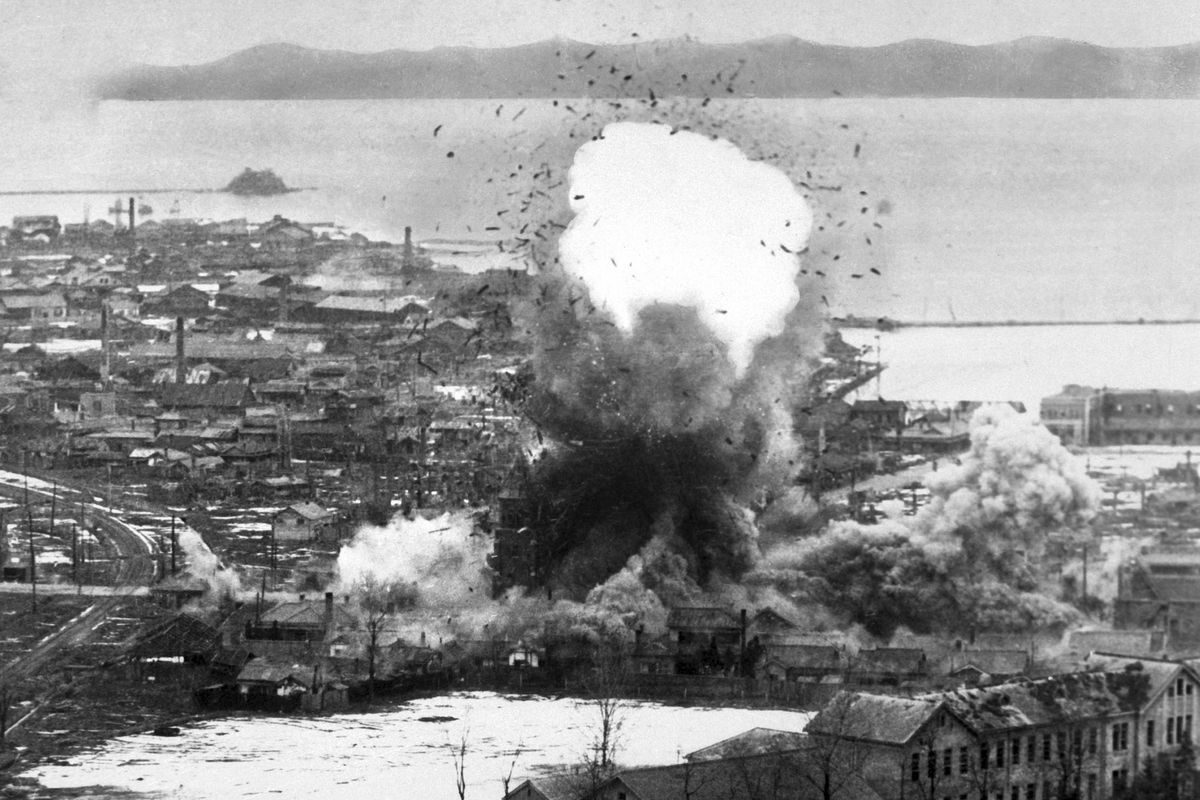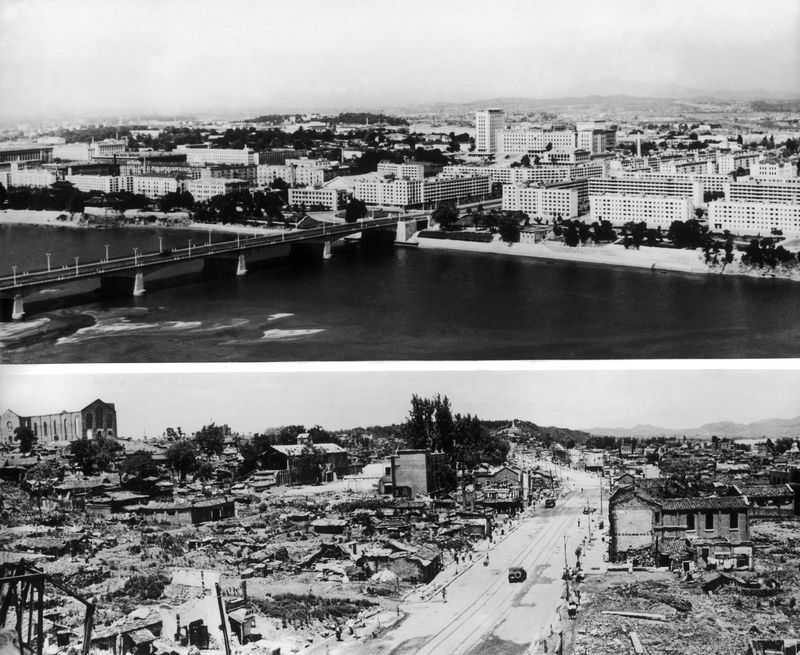
And there is another misconception, one that Americans might not want to hear but that is important for understanding the hermit kingdom: Yes, much of its anti-Americanism is cynically manufactured as a propaganda tool, and yes, it is often based on lies. But no, it is not all lies. The US did in fact do something terrible, even evil to North Korea, and while that act does not explain, much less forgive, North Korea's many abuses since, it is not totally irrelevant either.
That act was this: In the early 1950s, during the Korean War, the US dropped more bombs on North Korea than it had dropped in the entire Pacific theater during World War II. This carpet bombing, which included 32,000 tons of napalm, often deliberately targeted civilian as well as military targets, devastating the country far beyond what was necessary to fight the war. Whole cities were destroyed, with many thousands of innocent civilians killed and many more left homeless and hungry.
For Americans, the journalist Blaine Harden has written, this bombing was "perhaps the most forgotten part of a forgotten war," even though it was almost certainly "a major war crime." Yet it shows that North Korea's hatred of America "is not all manufactured," he wrote. "It is rooted in a fact-based narrative, one that North Korea obsessively remembers and the United States blithely forgets."
And the US, as Harden recounted in a column earlier this year, knew exactly what it was doing:
"Over a period of three years or so, we killed off — what — 20 percent of the population," Air Force Gen. Curtis LeMay, head of the Strategic Air Command during the Korean War, told the Office of Air Force History in 1984. Dean Rusk, a supporter of the war and later secretary of state, said the United States bombed "everything that moved in North Korea, every brick standing on top of another." After running low on urban targets, U.S. bombers destroyed hydroelectric and irrigation dams in the later stages of the war, flooding farmland and destroying crops.Historians dispute just how important this bombing really was in making North Korea the country that it is today; some say it was formative in shaping the young nation's history, others that North Korea was already on its way to becoming the hermit kingdom and that its leaders merely exploited the bombing to get there.
As the North Korea scholar B. R. Myers points out in The Cleanest Race, perhaps the definitive study of the North Korean worldview, anti-American propaganda was already in full swing before the bombing began. Since then, it has not focused as much on the American bombing (which Myers, like most scholars, considers a war crime) as you might expect:
As might be expected, the Korean War occupies a central place in anti-American propaganda, but the [propaganda] dwells less on the US Air Force's extensive bombing campaign (which is hard to reconcile with the myth of the protective leader) than on village massacres and other isolated outrages.Yet even if the bombing did not cause North Korea's obsessive hatred of America and Americans, it did help to focus it. The effects of the bombing were felt nearly universally, the suffering it caused among the first shared experiences for North Koreans. Unlike the propaganda, which only recounted supposed American crimes, here was a real American crime that everyone could see for themselves, and indeed had likely affected them personally. How could it not be formative?
American bombing, to be clear, did not transform North Korea from a nice country into a bad one; the seeds of the country's generations-long fascist rule had already taken root by the early 1950s, and indeed it is worth remembering that the North had launched the war in the first place. But that bombing did end up abetting, however unintentionally, the Kim family project of creating a paranoid, volatile, and oppressive bunker state.
You can see this, for example, in Pyongyang, the North Korean capital, which was all but razed by American bombing. As Myers points out, "The destruction of the original city by American bombs enabled the regime to re-design it from scratch as a grand and enduring work of propaganda in its own right."

In the rare moments when we do talk about the US bombing of North Korea, it can be easy to get lost in debating its long-term political consequences. But the bombing primarily mattered at the time, and still matters today, not because it was politically counterproductive, but because it was horrific and unjust.
You can glimpse both the humanitarian and political consequences in an alarmed diplomatic cable that North Korea's foreign minister sent to the United Nations, which was nominally leading the war effort, in January 1951. Scholar Adam Cathcart dug up the cable a few days ago, which is what got me thinking again about the bombing that America has largely forgotten. Here are some excerpts from the cable, haunting to read today:
ON JANUARY 3 AT 10:30 AM, AN ARMADE OF 82 FLYING FORTRESSES LOOSED THEIR DEATH-DEALING LOAD ON THE CITY OF PYONGYANG. ...Even in the English translation from the original Russian, the seeds of North Korea's now famously vituperative and conspiratorial rhetoric are easy to see; there is an odd reference to "Wall Street bosses" supposedly driving the war.
HUNDREDS OF TONS OF BOMBS AND INCENDIARY COMPOUND WERE SIMULTANEOUSLY DROPPED THROUGHOUT THE CITY, CAUSING ANNIHILATING FIRES. IN ORDER TO PREVENT THE EXTINCTION OF THESE FIRES, THE TRANS-ATLANTIC BARBARIANS BOMBED THE CITY WITH DELAYED-ACTION HIGH-EXPLOSIVE BOMBS WHICH EXPLODED AT INTERVALS THROUGHOUT FOR A WHOLE DAY, MAKING IT IMPOSSIBLE FOR THE PEOPLE TO COME OUT ONTO THE STREETS. THE ENTIRE CITY HAS NOW BEEN BURNING, ENVELOPED IN FLAMES, FOR TWO DAYS. BY THE SECOND DAY 7,812 CIVILIANS' HOUSES HAD BEEN BURNT DOWN. THE AMERICANS WERE WELL AWARE THAT THERE WERE NO MILITARY OBJECTIVES LEFT IN PYONGYANG. ...
THE NUMBER OF INHABITANTS OF PYONGYANG KILLED BY BOMB SPLINTERS, BURNT ALIVE AND SUFFOCATED BY SMOKE IS INCALCULABLE, SINCE NO COMPUTATION IS POSSIBLE. SOME FIFTY THOUSAND INHABITANTS REMAIN IN THE CITY, WHICH BEFORE THE WAR HAD A POPULATION OF FIVE HUNDRED THOUSAND.
But while today's North Korean anti-American rhetoric is so often filled with obvious distortions and lies and thus easy to dismiss, this piece of anti-American rhetoric is chillingly real. That makes the cable jarring to read even beyond the sheer awful suffering it describes. It was a moment when the official North Korean characterization of America, one that we today rightly consider propagandistic nonsense, had a lot of truth to it.



There is much more to this tail then a simple bombing campaign.
Readers need to dig deeper to find the truth.
Vietnam is a good example of what the U.S. was trying to do in Korea.
I find it rather revealing, that everywhere the U.S. goes, countries are always split in half.
Strange No ?